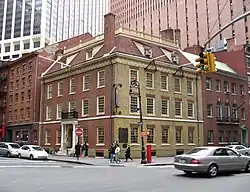Pearl Street (Manhattan)
Pearl Street is a street in the Financial District in Lower Manhattan, running northeast from Battery Park to the Brooklyn Bridge with an interruption at Fulton Street, where Pearl Street's alignment west of Fulton Street shifts one block south of its alignment east of Fulton Street, then turning west and terminating at Centre Street.

History
The history of Pearl Street dates back to the early 1600s, when the Dutch first settled on the southern tip of Manhattan. Its name is an English translation of the Dutch Parelstraat (written as Paerlstraet around 1660). This street, visible on the Castello Plan along the eastern shore of New Amsterdam, was named for the many oysters found in the river. During the period of British rule, Pearl Street was known as Great Queen Street. The "Great" was used often to differentiate from Little Queen Street, which became Cedar Street in 1784.
Pearl Street generally marked the original eastern shoreline of the lower part of Manhattan Island, until the latter half of the 18th century when landfill over the course of several hundred years has extended the shoreline roughly 700–900 feet (200-300m) further into the East River, first to Water Street and later to Front Street.
In the mid-1650s, a three-story tavern near what is now 73 Pearl Street became the city's first City Hall.[1]
Pearl Street Station, Thomas Edison's first power plant, and in turn the first power plant in the United States, was located at 255-257 Pearl Street. It began with one direct current generator, and it started generating electricity on September 4, 1882.
The IRT Third Avenue elevated railway ran above Pearl Street from August 26, 1878 until December 22, 1950.
New York Telephone put up a large administrative building at 375 Pearl on the north side of the street, east of the Brooklyn Bridge, in the early 1970s.
In 2014, playwright and theater artist Toni Schlesinger's "The Mystery of Pearl Street"—about the 1997 disappearance of artists Camden Sylvia and Michael Sullivan from their Pearl Street apartment following a dispute with their landlord[2]—debuted at the Dixon Place theater.
See also
References
- "Design Commission - City Hall Pre-Visit Guide". nyc.gov. Archived from the original on 3 May 2010.
- Newman, Andy (February 11, 1999). "Police Search of Building Where Missing Couple Lived Is Fruitless". New York Times. New York.
External links
 Media related to Pearl Street (Manhattan) at Wikimedia Commons
Media related to Pearl Street (Manhattan) at Wikimedia Commons- Pearl Street: A New York Songline
- NYPL Digital Gallery. Pearl St. items, various dates.